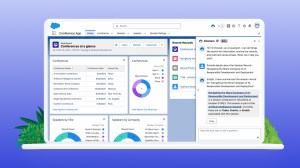Quick take: Salesforce’s global survey of IT leaders working across industries illustrates how companies are rethinking their strategies and tactics amid rising demand for their services, app proliferation, security threats, and ongoing developments in artificial intelligence.
A new survey of over 4,000 IT leaders reveals that while most (74%) expect near-term demands from the business to grow, further stretching over-capacity teams, advancements in AI and automation are seen as increasingly viable and transformative solutions.
In fact, 86% of IT leaders now expect generative AI to play a prominent role at their organizations in the near future.
86% of IT leaders now expect generative AI to play a prominent role at their organizations in the near future.
Salesforce’s latest State of IT report dives into these trends and offers a pulse check on leaders’ priorities, challenges, and strategic direction moving forward.
Here are five key takeaways from the analysis.
1. AI and automation are top-of-mind
Seventy-eight percent of IT leaders believe the role of AI in their organizations is well-defined. The meteoric rise of generative artificial intelligence opens new opportunities in IT’s pursuit for efficiency and scale.
In March, a separate survey of IT leaders found that 57% considered generative AI to be a ‘game changer’ with the potential to boost customer and employee experiences alike. Today’s research finds that sentiment is growing stronger. In fact, 86% of IT leaders now expect generative AI to play a prominent role at their organizations in the near future, with the vast majority saying their staff and their business stakeholders have a firm grasp on how it can be effectively leveraged.
Despite their enthusiasm for generative AI’s potential, IT leaders have some continued reservations. Nearly two-thirds (64%) of IT decision-makers are wary about the technology’s ethical implications, and 62% expressed concern about its potential impact on their careers.
Still, 87% percent of IT leaders expect more investment in automation at their organizations over the next 18 months, reflecting the fact that 58% are not fully satisfied with the level of automation they currently have implemented.
It is likely the industry will see these trends impact IT planning and execution in years to come as these technologies and their roles in business and society evolve.
2. Security threats continue to cast a shadow
Rapidly evolving technologies enable businesses to create innovative apps, yet they can also introduce new security vulnerabilities bad actors could exploit. This is prompting a dilemma for IT teams and their stakeholders, as 67% of IT leaders report having trouble balancing business and security objectives.
While the list of threats to worry about is long, malware, phishing, and vulnerable legacy systems are of particular concern. In response, teams are adopting a variety of security tactics, with data encryption being especially popular.
3. As business demands increase, IT teams focus on operational efficiency
Today, nearly two-thirds (62%) of IT organizations have trouble meeting business demands — a figure expected to rise as 74% of IT leaders expect further increased demand over the coming 18 months.
Fortunately, 69% of IT leaders expect budget increases over the next 18 months and 57% expect additional headcount. Yet, teams are also concentrated on making the best use out of their current resources, with 89% increasingly focused on operational efficiency.
“IT departments continue to be asked to do more with less, save on costs, deploy products faster, and deliver better customer and employee experiences. So it’s critical for CIOs and IT leaders to focus on operational efficiency and process excellence,” said Param Kahlon, EVP and GM, Automation & Integration, Salesforce. “By doing so, teams will be more productive and achieve business success moving forward.”
Misalignment across departments prevents IT from prioritizing the most valuable initiatives. Just 35% of IT leaders feel their key performance indicators (KPIs) are completely aligned with those of other departments. While IT leaders rank project return on investment and project speed as their top success metrics, the low sentiment regarding alignment suggests that coordination with sales, service, marketing, operations and other departments needs improvement.
4. Data proliferation and business demands prompt new approaches to application development and integration
Demand for apps is on an unceasing upward trajectory. Sixty-nine percent of IT leaders expect demand for customer-facing apps to increase over the coming 18 months, and 63% say the same for employee-facing apps.
This is troubling when just 26% of organizations can support all development requests they currently receive.
The mismatch of app demand and supply requires new approaches. Low-code and no-code tools are examples that have seen impressive uptake — currently used by 77% of IT departments. Another example is composability, which means using standardized, reusable building blocks of packaged capabilities in favor of custom code. Forty-six percent of IT departments have composable design strategies, with an additional 43% planning implementation.
But developing apps in the first place is just one piece of the puzzle. With workflows increasingly requiring data from various sources, 88% of IT leaders view system/application integration as critical for both customer and employee experiences. Enterprises are now using an average of 1,061 different applications. Despite this number increasing every year, only 29% of applications are estimated to be integrated — a figure that has remained stubbornly flat over the years.
5. Sustainability is on the IT agenda
Beyond the day-to-day priorities and challenges IT leaders confront, there are other, more consequential issues they must contend with, like climate change. With new sustainability reporting requirements, carbon accounting is increasingly coming under IT’s purview. Seventy-nine percent of IT organizations have set greenhouse gas emission reductions, and 87% of those organizations’ leaders feel they can effectively track and report those emissions. However, the work doesn’t stop there, as many frontline employees report needing additional training to meet the emissions goals.
More information
- Read the full State of IT report
- Learn about the Salesforce Platform’s automation capabilities
- Meet AI Cloud
Methodology
Unless cited otherwise, data is from a double-anonymous global survey of 4,325 IT professionals with a title of director or higher that took place between February 28 and April 5, 2023. Additional methodology and survey demographic details can be found in the State of IT report.















